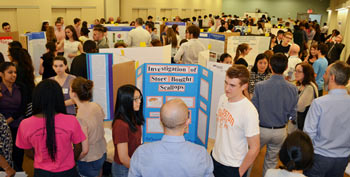 The Urban Barcode Project (UBP) is a science program spanning the five boroughs of New York City and the surrounding metropolitan area. Just as a unique pattern of bars in a universal product code (UPC) identifies each item for sale in a store, a DNA barcode is a DNA sequence that uniquely identifies each species of living thing.
The Urban Barcode Project (UBP) is a science program spanning the five boroughs of New York City and the surrounding metropolitan area. Just as a unique pattern of bars in a universal product code (UPC) identifies each item for sale in a store, a DNA barcode is a DNA sequence that uniquely identifies each species of living thing.
The UBP is the first large-scale effort to engage high school students using DNA technology to explore biodiversity in New York City. The Alfred P. Sloan Foundation supported the first round of the UBP from January 2011 through June 2012. Since 2012, the UBP has continued to promote the exploration of biodiversity in New York City and expanded into the metropolitan area. The UBP is currently supported by The Thompson Family Foundation.
Projects can use DNA barcodes to examine any aspect of the environment, such as:
- Sampling biodiversity in a park, garden, office, or school;
- Checking for invasive plant or animal species;
- Monitoring disease vectors;
- Identifying exotic or endangered food products in markets; and
- Detecting food mislabeling.
Who can participate?
The program is open to high school students in the New York Metropolitan area who are enrolled in grades 9–12. Teams of 2–4 students must be sponsored by a qualified science teacher (see below on how to qualify) or mentor. A mentor can be an undergraduate or graduate student, Ph.D. researcher, or any person with a working knowledge of DNA barcoding and/or ecology who is willing to spend sufficient time with a high school student team. Team members do not have to be from the same school.
How do I join and what is the project timeline?
- Form a team of 2-4 NYC high school students and a qualified science teacher or mentor.
- Develop a project proposal.(See guidelines and example in the "Project Guidelines" section of this website)
- Submit your proposal on this website by the published deadlines.
- Proposals will be judged for originality, creativity, relevance, plausibility, and scientific merit. The top teams will be invited to take part in the Urban Barcode Project.
- Invited teams must complete their projects by the spring semester and present their work at a project symposium.
Symposium
The 2024-25 Urban Barcode Project Student Symposium will be held Tuesday, May 20, 2025 at the New York City College of Technology (City Tech) in Brooklyn.
What will the proposal entail?
The formatted project proposal should include:
- Introduction and literature review, with references about similar types of research;
- Relevance to New York City or national issues;
- Goals and expected outcomes;
- Methods, including how samples will be collected and processed to produce DNA barcodes; and
- Brief biographies of each team member.
What happens if my team's proposal is selected?
Each selected team will have free access to everything needed for their DNA barcode experiments, including equipment, protocols, and reagents for DNA extraction, PCR, and DNA sequencing for up to 30 samples. Teams may attend Open Lab days at designated locations where they can get additional training and access equipment to complete portions of their experiments. Loaner equipment will be available for use by individual schools, or groups of nearby schools to share.
For Teachers and Mentors
How can a science teacher or mentor get training to sponsor a team?
Science teachers who wish to sponsor teams must participate in a training workshop provided by the DNA Learning Center. Student project proposals will only be accepted if a sponsoring teacher has received official training. Training is not required for mentors with previous experience in DNA barcoding. For more information and to register for a DNA barcoding mentor workshop, visit the Teacher Training page.
How many teams can a teacher or mentor sponsor?
A teacher or mentor can work with up to five student teams.

